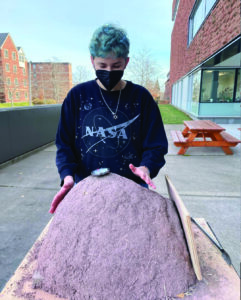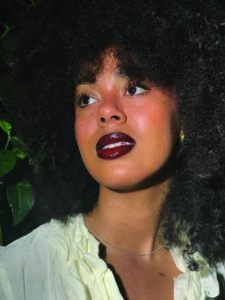Silence, bangs and clangs, giggling, thuds as someone walks down the stairs, the creak of the doors opening on their way out, silence. These are the typical sounds of the Purdy Crawford Centre for the Arts. A place where new artworks appear on the walls, random drawings and stickers lie throughout, and a shrine to a teddy bear in a little rocking chair is set underneath the stairs (I will leave you to figure out which ones). It almost seems by magic that all this happens, as more often than not the building seems nearly empty, but I assure you it is not.
“There is a stereotype that fine arts students do not work as hard as others,” said Bex Steinberg, a third-year fine arts student. “People believe we just sit around and do our silly little drawings. But we do a lot. Our education is well-rounded, and we have to work hard. So, just because our work looks different […] does not mean it does not take a lot [of effort].” After spending just an hour with these students, I absolutely agree. While most students choose two areas to specialize in (their major and minor), fine arts students choose three areas of art to work towards, gain skills in, and produce art for. However, that is just the tip of the iceberg. They are history students, English majors, chemists, technicians, and so much more all for the sake of their art. These students change the definition of art and rewrite it to fit their creativity. For instance, for an art project, Steinberg built a working oven out of clay.
Arguably, pursuing the fine arts is not for the faint of heart; Steinberg described it as “demanding.” For one, it is apparently the second most expensive major because students are in charge of buying their own art supplies.
“It is a lot of project-based work with new deadlines every few weeks, except in fourth year, where you work at your own pace and decide what you want to work on,” Alexandria Gilliss, a fourth-year fine arts student, explained. However, perhaps the biggest challenge is in creating the art itself; not only can it be a physically demanding process (such is the case with print-making), but mentally challenging. These students have to consider the message—if any—that they want to impart in their art. “With an art piece, you decide when you are done. It is not like the other programs where you have essays or lab reports and you just know,” Steinberg expressed.
However, it is absolutely worth it to pursue the fine arts, and I have become a believer in the idea that everyone should take at least one fine arts course in their life. “I am building a base of skills I can take with me no matter what I do,” Steinberg stated.
“While any intensive art practice has its ups and downs, and requires a lot of personal exploration and hard work, the professors and environment at Mt. A do a great deal to encourage and facilitate students’ growth as artists and critical thinkers,” says Kaya Panthier, a second-year fine arts student.
“The community is great too, because a lot of us have shared most of our classes for years. […] We always know where to find somebody if we need help,” Gilliss stated.
Steinberg agreed: “the people have been my favorite part. [The community] is so supportive, people are always happy to see your work and share their knowledge.”
When asked about what inspires their art, Gilliss said, “I draw a lot of inspiration from my surroundings, and artists who work from the domestic. I find it interesting how varied and unique responses to the same subject can be.” For her, art is a way to connect with others and express herself. Steinberg, in contrast, expressed that they have no one source of inspiration. However, they are inspired by such things as images from classical antiquity and interaction with light.
Panthier draws inspiration from her multicultural identity and experience as a Black woman. “It is an integration of my Afro-Caribbean and North American experiences. As well, I draw a lot of inspiration from the natural world and our ability to be both nurtured by it and lost in it.” She described art as giving her a space in which she can “explore, grieve, celebrate, and connect with others. Art is a necessary tool along the constant journey to discover [herself] and express [her] values.” Currently, Panthier is working on a series of pieces exploring Caribbean folklore and superstition as they relate to her “Black womanhood, spirituality, death, generational trauma, and maturation.” This series includes a variety of mediums.
“If you are someone who feels driven to make art, this process is incredible fulfilling. The constant growth that occurs when you push yourself to create, but also to step back and understand the cultural context and the function of your work is incredibly rewarding,” Panthier expressed. So, there it is: fine arts students are awesome and deserve thunderous applause and support for all the work they put into their creations. I implore everyone to support these students, attend their shows, buy their art, or talk to them about their work. The fourth-year students will be hosting a show in Owens Art Gallery at the end of the year, so look for more information on that and visit it when it opens.








